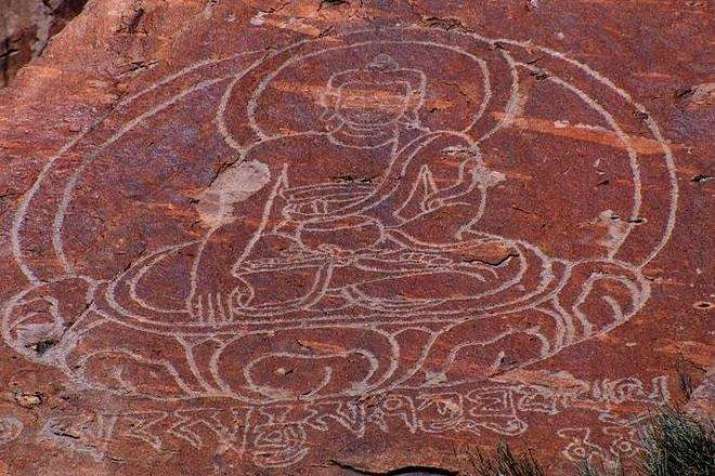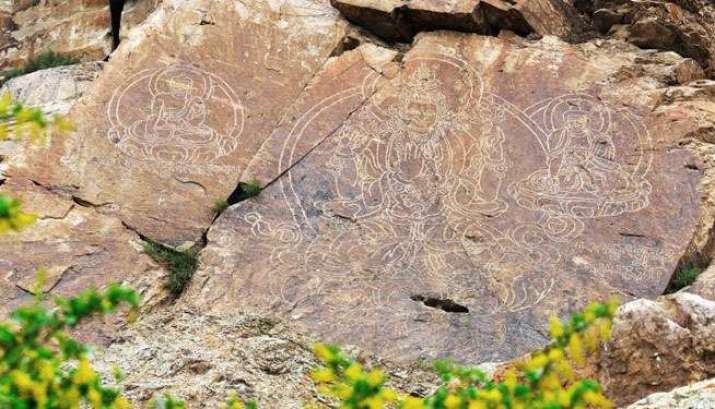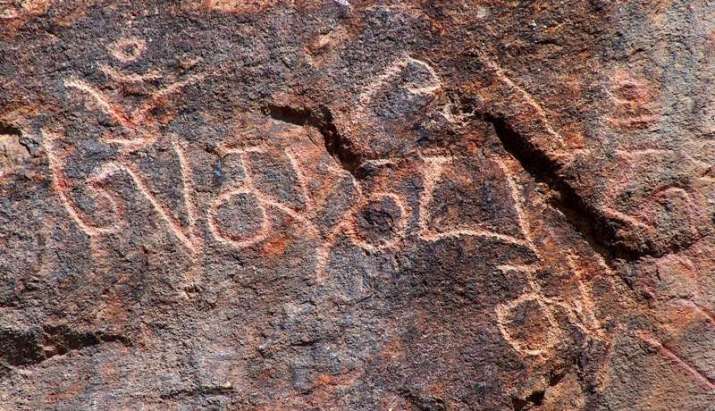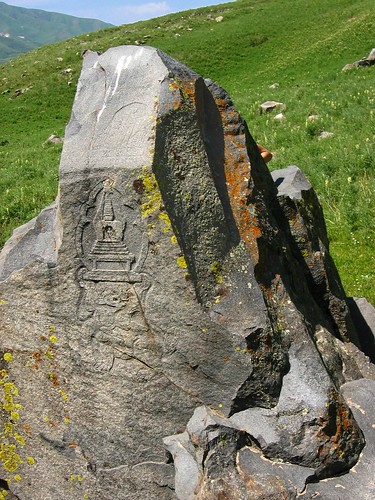FEATURES|REGIONS|Europe / Russia
The Buddhist Face of Kazakhstan
 An image of Shakyamuni Buddha at Tamgaly-Tas with a Tibetan inscription reading “Sange Shakyatupa la namo” or “Homage to Shakyamuni Buddha!” From indy-guide.com
An image of Shakyamuni Buddha at Tamgaly-Tas with a Tibetan inscription reading “Sange Shakyatupa la namo” or “Homage to Shakyamuni Buddha!” From indy-guide.comThe spread of Buddhism in Russia has a long and interesting history. In recent years, in addition to the three Russian Buddhist republics of Buryatia, Kalmykia, and Tuva, St. Petersburg and Moscow have also became centers for Dharma activities.
The Republic of Kazakhstan, which was part of the Soviet Union from 1936–91, is rarely connected to Buddhist history. The largest landlocked country in Central Asia and the ninth-largest country in the world, with a population of 18 million, Kazakhstan is known as the “land of the great steppe,” its territory historically inhabited by Turkic nomads. In the 13th century, the steppes became part of the Mongolian empire under Genghis Khan (1162-1227). Around the 16th century, the Kazakh emerged as a distinct group, and by the middle of the 19th century, the Russian empire controlled all of Kazakhstan.
Modern Kazakhstan is a multi-ethnic republic with a long tradition of religious tolerance. It is home to 131 ethnic groups, all of which have religious freedom. The majority religion is Islam, with Orthodox Christianity the second-largest, followed by Roman Catholicism. The traditional beliefs of the Kazakh people are Neo-Paganism, Tengrism, Shamanism, and Animism. Buddhism is a minority religion, along with Protestant Christianity, Hinduism, Judaism, and the Baha’i faith.
 Shakyamuni Buddha, Avalokiteshvara, and the Medicine Buddha at Tamgaly-Tas. From advantour.com
Shakyamuni Buddha, Avalokiteshvara, and the Medicine Buddha at Tamgaly-Tas. From advantour.comThe history of Buddhism in Kazakhstan is far less well known. From as early as the 6th century, Buddhism had a strong impact on the Turkic people. The Western Turkic Khaganate or Western Turkic Empire, which included modern Kazakhstan, Uzbekistan, and parts of Kyrgyzstan, Tajikistan, Turkmenistan, and Russia, was a great patron of Buddhism from the early 7th to the early 8th century, and Buddhism reached Kazakhstan during the later 7th and early 8th centuries. In 10th century, Islam was declared the state religion by the Karakhanid dynasty,* which led to a weakening of Buddhism. But from the 15th–18th centuries, Buddhism in the land of the great steppe began a revival due to the attacks of the Dzungar people.**
Many Buddhist artifacts can be found in the former Soviet Republic, the two of the most emblematic artifacts being the Tamgaly-Tas (“Stones with Signs”) and Tekeli Stela.
Located 170 kilometers to the northwest from Almaty, the largest city in the republic, Tamgaly-Tas is a UNESCO World Heritage Site and one of Kazakhstan’s most popular tourist destinations. The huge cliffs are marked with thousands of rock paintings and carvings dating from the Bronze Age onward. Impressive images of the Buddhas and Bodhisattvas along with Tibetan inscriptions can be seen there.
Tekeli Stela, near the city of Tekeli in Almaty, is a three-meter-high rock that looks like a pyramid. It is engraved with images that are typical of Tibetan Buddhism: a stupa, a snow lion holding the stupa, and the monogram of the Kalachakra (“The Wheel of Time”).
 The mantra “Om Mani Padme Hung” inscribed in the Tibetan script at Tamgaly-Tas. From silkadv.com
The mantra “Om Mani Padme Hung” inscribed in the Tibetan script at Tamgaly-Tas. From silkadv.comThere are two Buddhist organizations officially registered in Kazakhstan, located in Almaty and in Western Kazakhstan respectively. The first is the Almaty Church of Won Buddhists, founded in 1997. Won Buddhism is a modernized form of the Buddha’s doctrine established in Korea. Its founder, Bak Jungbin (1891–1943), is regarded by his followers as a Buddha of the new era. The philosophy of Won is that the final goal of enlightenment is achievable for everyone and is applicable to daily life. Its teachings and practices are simplified and made accessible to people from different spheres of society. The main doctrine of Won Buddhism was published in the Bulgyo Jeongjeon (The Correct Canon of Buddhism) in 1943. Won is sometimes defined as a new religious movement due to the major changes it made to traditional Korean Buddhist practices. Although in Korea it is not a recognized Buddhist order, in Kazakhstan its followers are accepted as Buddhists. The Almaty Church of Won Buddhists has its own religious building and its director is Larisa Palangina. Their main teacher, Kim Tae-il was born in South Korea and has lived in Almaty for more than 20 years.
The second Buddhist organization in Kazakhstan is the Local Buddhist Religious Association of the West Kazakhstan Region (Western Kazakhstan) in the city of Uralsk. Founded in 1996 under the Tibetan Geluk school, the resident teacher is Geshe Lharamba Jigme Wangchuk, who was sent to Uralsk from Drepung Gomang Monastic University in southern India with the blessing of His Holiness the Dalai Lama and his honorary representative to Russia, Mongolia, and the members of the Commonwealth of Independent States, Telo Tulku Rinpoche. The director of the association is Lyudmila Bykova.
Buddhist groups exist in other cities but they are not officially registered—example are the Kazakhstan Diamond Way Buddhist Centers, related to the Karma Kagyu school and the Danish lama Ole Nydahl.
In 2013, an auspicious stupa aimed at protecting Almaty from earthquakes and other natural disasters was built in Raiymbek District. The Khazakh Alexandr Gritskov, a monk in a Tibetan monastery in Dharamsala, along with Tenzin Thinley, a Buddhist teacher from a monastery in the same Indian city, helped with the construction of this six-meter stupa. The heart of the sacred monument contains relics of enlightened teachers, enabling it to spread blessings and powerful energy in the region. It was built under the guidance of His Holiness the Dalai Lama.
* The Turkic dynasty (999–1211) that ruled in Transoxania—a historical region of Turkistan in Central Asia, corresponding to present-day Uzbekistan and parts of Turkmenistan, Tajikistan, and Kazakhstan.
** The Dzungar people referred to the several Oirat tribes, the westernmost group of the Mongols whose ancestral home is in the Altai region of western Mongolia. Dzungars formed and maintained the Dzungar Khanate in the 17th and 18th centuries. Khanate is a political entity ruled by a Khan—a title for a sovereign or a military ruler, used by Mongolians living to the north of China.
See more
Historical Sites Recall When Kazakhstan Was Buddhist (The Astana Times)
Буддисты Алматы (Radio Azattyq)
Буддист придумал способ спасения Алматы от землетрясения (Tengri News)
Буддизм в Казахстане (International Center of Cultures and Religions, Republic of Kazakhstan)
Related features from Buddhistdoor Global
Russia’s Golden Triangle of Buddhism
International Conference in Tuva Marks Revival of Buddhism in Central Asia
A History of Buddhism in Russia: Tensions with the Tsars
Our Buddhist Lands: The Heritage of Central Asia
Buddhistdoor View: Buddhist Hopes for China’s Silk Road Initiative















